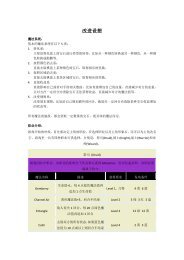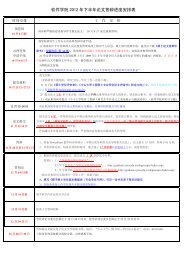A more secure steganography based on adaptive pixel-value ...
A more secure steganography based on adaptive pixel-value ...
A more secure steganography based on adaptive pixel-value ...
Create successful ePaper yourself
Turn your PDF publications into a flip-book with our unique Google optimized e-Paper software.
Multimed Tools Applare inevitably c<strong>on</strong>taminated by such a random selecti<strong>on</strong> scheme, which will lead topoorer security performances <str<strong>on</strong>g>based</str<strong>on</strong>g> <strong>on</strong> our extensive experiments.5 C<strong>on</strong>cluding remarksIn accordance with the limitati<strong>on</strong>s of the existing PVD-<str<strong>on</strong>g>based</str<strong>on</strong>g> schemes, an <strong>adaptive</strong>and <str<strong>on</strong>g>more</str<strong>on</strong>g> <str<strong>on</strong>g>secure</str<strong>on</strong>g> steganographic method has been studied in the paper. Quitedifferent from typical PVD and it improved versi<strong>on</strong>s, whose embedding positi<strong>on</strong>sare mainly determined by a PRNG without c<strong>on</strong>sidering the relati<strong>on</strong>ship betweenthe image c<strong>on</strong>tents and the size of the message to be embedded. Our novel methodcan first embed secret bits at the sharper regi<strong>on</strong>s <strong>adaptive</strong>ly, while keeping thosesmooth/flat regi<strong>on</strong>s as they are. Besides that, the new method does not destroy sortrelati<strong>on</strong>ships between the three c<strong>on</strong>secutive <strong>pixel</strong>s within all the embedding units.In such a way, fewer visual artifacts and detectable artifacts will be introduced.The experimental results evaluated <strong>on</strong> a large image database show the significantimprovements in terms of adaptability and security compared with the existing <strong>on</strong>es.In the future step, we will investigate whether our proposed idea can be applied toother steganographic schemes that in the frequency domain for enhancing security.Acknowledgements This work is supported by the NSFC (60633030), 973 Program(2006CB303104), China Postdoctoral Science Foundati<strong>on</strong> (20080440795), Funds of Key Labof Fujian Province University Network Security and Cryptology (09A011) and Guangzhou Scienceand Technology Program (2009J1-C541-2).AppendixFigure 8 illustrates the four different cases according to the <strong>pixel</strong> <strong>value</strong>s g i , g i+1 , g i+2within an embedding unit and a given threshold T. Note that g i and g i+2 are fixedbefore and after data embedding. In this appendix, we want to show you how todetermine the range of the centre <strong>pixel</strong> <strong>value</strong>s range g ′i+1so that the sort order of thethree c<strong>on</strong>secutive <strong>pixel</strong> <strong>value</strong>s and the relati<strong>on</strong>ships between the <strong>pixel</strong> <strong>value</strong>s and Tare well preserved after data embedding.gi+2gi+1TgiTgi+2giTgi+1(a) Case 1gi(b) Case 2gi+2gi+1TT(c) Case 3gi+2gigi+1T(d) Case 4Fig. 8 Four different cases according to the <strong>value</strong>s of g i , g i+1 , g i+2















